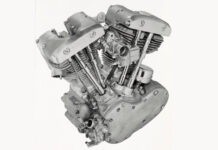Let’s get this out of the way up front. Last month I made the wish (in print) that Harley would give the new 2018 cruiser lineup a chassis to match the capabilities, character and potential of the Milwaukee-Eight powerplant. They have! I’ve ridden them all and will talk about that… soon enough. For now, it needs to be said that Dyna and FXR fans (of which I am one of the biggest) need to shut up or stay home. After you’ve ridden any version of (as I call ’em) “Softail 3.0”—you just won’t have a valid beef. (Well, except maybe the looks of some of them. “Beauty in the eye” and all that jazz.)
Transformed from archaic “profiler” cruiser… no one could be any more surprised than yours truly that the Motor Company has built a handler… a serious handler! Trust me, this ain’t your daddy’s Softail… functionally, dynamically… it’s a whole new ball game! Light, tight and right! So, no more whining! No more sour grapes! You can’t beat ’em… so join ’em! The 2018 Softails, that is.
Eight models—two displacements—one chassis = superb!
Aside from the marvelous M-8, both large and larger, eight iterations of the classy new chassis…(which you have no doubt seen and read about already)… there’s this kind of core “stuff” that needs a mention… or more! Mostly, my intentions, do not include a lengthy “show and tell” of the features that will make you want to buy one. What I’d like to get at instead, is what will make you understand what has been done to make owning and using one easier and better… especially over time. Also, hopefully, you’ll come away with an insight or two into why certain things (from the ridiculous to the sublime) are the way they are on these bikes. Call them… ah… “hidden assets.” Anyway, all this is best accomplished with pictures and captions, with my thoughts continued in next month’s Motorhead Memo. So… in no particular order… here we go.

“All Softail models will have a 42-amp charging system to support an increased amount of accessory potential.”—quoth H-D. Ah… yeah… sure… whatever. Obviously, the truth is more like “the M-8 engine has a badass alternator—so now it’s in Softails.” Clearly, this is no bad thing. I mean, there’s room to doubt that any Softail—ever—will have 900-watt stereos, heated gloves, gear, seats, GPS, and a bunch more stuff that drove the decision to bump the juice in baggers. But it’s nice to know the bike could handle it. (In fact, it’s worth noting, it’s perhaps the first time in history any motorcycle has had more charging capability than it will ever need.

The clutch it connects to is improved as well. The factory nomenclature is a little clumsy… they refer to this design as “assist and conventional clutch” intended to offer the functional best of both worlds… a smooth engagement… acting in conjunction with a beefy regular clutch. Good enough! But it gets a lot more intriguing when you realize the Touring bikes get an “assist and slip” clutch! WTF? What does that mean? Well, it’s all about that nasty, scary, tire-squealing, traction-breaking moment that’s been known to occur after a rapid downshift… or series of same. Softails with the new, light monoshock design will never have anything like as much unsprung weight (or flex in the arm) as the twin-shock Touring bikes… not to mention the odds against carrying as much payload over the rear wheel. Translation: Baggers might need the slip feature in their clutches… but new third-gen Softies… don’t! Says a lot about the new-found road-holding capabilities of the Softail frame. Ain’t that great?

The main frame is the same for all Gen-3 Softails, the only difference being the two swingarms (standard and fat tire versions), but look very closely at reference number(s) 16 and 17 in this parts diagram. See it? Yup… it’s a spacer arrangement that makes belt replacement a fraction of the hassle it used to be! Shows the level of thought that’s gone into making this the best cruiser “platform” the factory has ever devised.

Softails also get a new two-piece clutch cable that disconnects at the adjuster via this red tab and a flat blade screwdriver. This means there’s no need to pull the end cover, make a mess, replace a gasket, worry about ball bearings, re-do the adjustment… yada, yada! Makes cable changes easier… way easier! Handlebar swaps get a little help from this feature also, as you can imagine. Gives the factory more cables to sell too… come to think of it. Is that a win-win?

An unheralded, but neat (and proprietary) trick for some 2018 models is the “Physical Vapor Deposition” (PVD) exhaust coating. Available in gloss black, satin black, a gorgeous sorta gun metal gray (although H-D calls it something else)… and a bronze tint. PVD is a process of vaporizing a solid metal into a plasma of atoms or molecules, deposited as a high-performance coating on steel pipe. This coating makes chrome look old hat and paint, powder or ceramic look lame! Not least because it’s four times harder than chrome (in fact second only to diamond hardness) which makes a very corrosion- and abrasion-resistant finish indeed! You’ll need to see it in person to get the full effect, but it won’t discolor, fade, or do much of anything but look terrific… for practically the life of the motorcycle. Another nice touch (not shown)—the fuel tanks have been redesigned on the whole line-up… including, importantly, having the fuel pump mounted from the bottom… no more weird plates, screws and crap to deal with, trying to get the thing out of the top of the tank. And, of course, the tanks look a lot cleaner! Nicely done!
Read Classy Chassis (Part II) here.




















[…] Last time around we talked briefly about a few of the neat (and unsung) supporting players in the total redesign of the 2018 Softails. This time… let’s dig a little deeper into the engine and chassis combo that’s got everyone rethinking Harley’s cruiser image. Or should! After all… dynamically… about the only thing these new machines have in common with what came before is the name! Here are some of the reasons why. […]